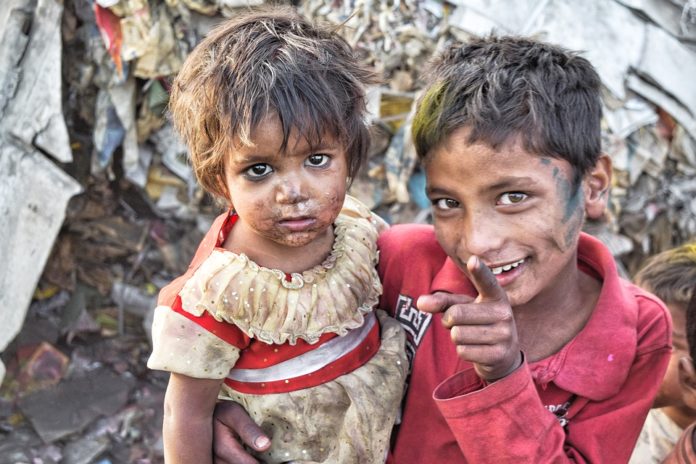
The first state level analysis of India’s child malnutrition burden throws few surprises; disease burden varies seven fold between states
Malnutrition has improved in India but it is still the underlying risk factor for two out of three deaths in under-five children, and it is also the leading risk factor for health loss in persons of all ages considered together.
The disease burden rate attributable to malnutrition in children varies 7-fold between the states, and is highest in Rajasthan, Uttar Pradesh, Bihar and Assam, followed by Madhya Pradesh, Chhattisgarh, Odisha, Nagaland and Tripura.
Among the malnutrition indicators, low birth weight is the biggest contributor to disease burden followed by child growth failure which includes stunting, underweight and wasting.
To achieve the National Nutrition Mission 2022 targets and the UNICEF/WHO 2030 targets, the rate of improvement in low birth weight, stunting, underweight, wasting, an anaemia in women and children, and exclusive breastfeeding have to accelerate further.
The prevalence of malnutrition indicators and their rates of improvement vary substantially between the states of India.
The momentum being built by the National Nutrition Mission to reduce malnutrition across India can utilise the trends reported in this paper as a reference to determine the additional effort needed in each state to meet the targets.
The first comprehensive estimates of disease burden due to child and maternal malnutrition and the trends of its indicators in every state of India from 1990 have been published in The Lancet Child & Adolescent Health by the India State-Level Disease Burden Initiative.
The findings show that two-thirds of the 1.04 million deaths in under-five children in India are attributable to malnutrition. Although the overall under-five death rate in India as well as the death rate due to malnutrition has decreased substantially from 1990 to 2017, malnutrition is still the leading risk factor for death in children under-five years for every state of India, and is also the leading risk factor for disease burden for all ages considered together in most states of India.
The findings show that two-thirds of the 1.04 million deaths in under-five children in India are attributable to malnutrition. Although the overall under-five death rate in India as well as the death rate due to malnutrition has decreased substantially from 1990 to 2017, malnutrition is still the leading risk factor
The malnutrition trends over about three decades reported in this paper utilized all available data sources from India, which enable more robust estimates than the estimates based on single sources that may have more biases. The state-specific findings described in this scientific paper highlight the extent of the effort needed in each state to achieve the national and global targets for various malnutrition indicators.
The India State-Level Disease Burden Initiative is a joint initiative of the Indian Council of Medical Research, Public Health Foundation of India, and Institute for Health Metrics and Evaluation in collaboration with the Ministry of Health and Family Welfare, Government of India, along with experts and stakeholders associated with over 100 Indian institutions, involving many leading health scientists and policy makers from India. This scientific paper involved a large number of collaborators, including many leading malnutrition experts from India. 2
On the release of these findings, Prof. Vinod K. Paul, Member NITI Aayog said, “The study findings are released at an opportune time when Government of India is intensifying its efforts to address the issue of malnutrition across the country. September is being observed as Poshan Maah with the aim of reaching every household with the message of nutrition. The trends reported in this scientific paper for every State indicate the efforts needed in each State to control malnutrition. State governments are being encouraged to intensify efforts to reduce malnutrition and undertake robust monitoring to track the progress. Focus on improving the overall nutritional status of girls and women during the preconception and pregnancy period, providing quality antenatal care will positively influence low birth weight indicators and extend the benefits to next generation.”
Prof. Balram Bhargava, Secretary to the Government of India, Department of Health Research, Ministry of Health & Family Welfare, and Director General, ICMR said, “In our commitment to the Poshan Abhiyaan, we are taking important steps to augment monitoring of malnutrition indicators across the country. The National Institute of Nutrition, an ICMR institute, and other partners are setting in place mechanisms to ensure that there are more data available on malnutrition in the various states of India which will help monitor progress. The findings reported in the paper published today highlight that there are wide variations in the malnutrition status between the states. It is important therefore to plan the reduction in malnutrition in a manner that is suitable for the trends and context of each state.”
“Inclusion of data from all available sources in India over three decades has enabled robust estimation of malnutrition trends for every state in this study, which is a useful reference for further efforts to improve nutritional status across India”, said senior author of the paper Prof. Lalit Dandona, who is Director of the India State-Level Disease Burden Initiative. “This study reports that malnutrition has reduced in India, but continues to be the predominant underlying risk factor for child deaths, underscoring it importance in addressing child mortality. It reveals that while it is important to address the gaps in all malnutrition indicators, low birth weight needs particular policy attention in India as it is the biggest contributor to child death among all malnutrition indications and its rate of decline is among the lowest. Another important revelation is that overweight among a subset of children is becoming a significant public health problem as it is increasing rapidly across all states of India.”













